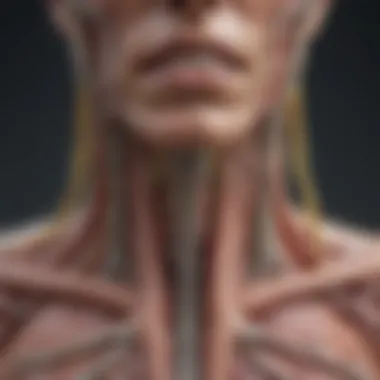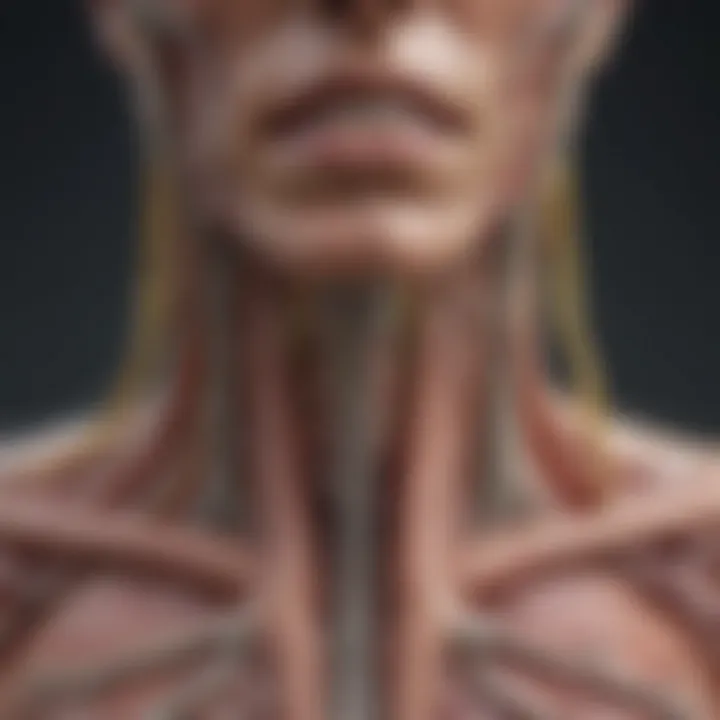Understanding Cholangitis: A Comprehensive Overview


Intro
Cholangitis is a significant medical condition that affects the bile duct system, leading to serious health complications. Understanding this inflammatory disease is crucial not only for healthcare professionals but also for researchers and individuals interested in digestive health. By discussing the underlying causes, typologies, diagnostic methods, and treatment options, this article aims to create a comprehensive resource for those navigating cholangitis.
Key Concepts and Terminology
Definition of Key Terms
To clearly understand cholangitis, one must first become familiar with certain key terms:
- Cholangitis: An infection of the bile duct characterized by inflammation, usually resulting from a bacterial infection that follows bile duct blockage.
- Bile Duct: A system of ducts that carry bile from the liver to the gallbladder and small intestine, involved in digestion.
- Sepsis: A life-threatening response to infection that can occur if cholangitis is not treated promptly.
Concepts Explored in the Article
In our exploration of cholangitis, several core concepts are examined:
- Causes and Risk Factors: Understanding what leads to cholangitis helps in the prevention and management of the condition.
- Types of Cholangitis: There are variations in presentation, making it essential to differentiate between types for proper treatment.
- Diagnostic Approaches: Effective diagnosis is key to initiating appropriate treatment, thus we will explore various diagnostic tools.
- Treatment Methodologies: Finally, we will look at different treatment options, including medical and surgical interventions, that aid in managing cholangitis.
Findings and Discussion
Main Findings
The research reveals several significant points regarding cholangitis. Firstly, it is most commonly associated with bile duct stones, tumors, or strictures that obstruct the normal flow of bile. This obstruction can create a conducive environment for bacterial growth, leading to infection and subsequent inflammation.
Moreover, the article highlights the importance of early detection. Signs and symptoms may include fever, jaundice, and abdominal pain. If not managed timely, cholangitis can escalate to severe complications such as sepsis.
Potential Areas for Future Research
Identifying cholangitis's subtle presentations remains a challenge, thus further research is necessary to:
- Develop improved diagnostic criteria that allow for earlier detection.
- Investigate the role of genetic predisposition in cholangitis.
- Explore innovative treatment modalities that minimize invasiveness while enhancing effectiveness.
"Cholangitis represents a complex interplay of anatomical, physiological, and pathological factors. A comprehensive understanding of these will enhance management strategies."
By focusing on these areas, the medical community can progress in both understanding and treating cholangitis effectively.
Preamble to Cholangitis
Cholangitis represents an essential topic within the realm of gastrointestinal disorders, primarily affecting the bile duct system. Understanding this condition is not only crucial for healthcare professionals but also for researchers and informed readers who wish to deepen their knowledge about digestive health. It holds significant clinical implications, as cholangitis can lead to severe consequences if not diagnosed and treated promptly. Therefore, proper exploration of its definition, historical context, types, symptoms, and management strategies is vital.
Definition of Cholangitis
Cholangitis is characterized as an inflammation of the bile duct system, triggered by infection and obstruction. The inflammation can result from various factors, including gallstones, strictures, or tumors, which disrupt the normal flow of bile. This disruption creates an environment conducive to infection, often leading to bacterial overgrowth. The most common form, acute cholangitis, is a medical emergency requiring immediate intervention. Patients may present with a triad of symptoms known as Charcot's triad, which consists of fever, jaundice, and abdominal pain.
Proper recognition of cholangitis is critical since timely treatment can significantly affect patient outcomes. Any delay may lead to complications such as septic shock or liver failure, making it imperative to understand this condition thoroughly.
Historical Context
The historical journey of cholangitis can be traced back to ancient medical texts; however, it gained more formal recognition in the 19th century. Early observations were primarily anecdotal, focusing on the symptoms rather than underlying mechanisms. Advancements in diagnostic techniques, such as imaging studies and endoscopic procedures, have played a crucial role in defining the disease and its management.
Notably, the term 'cholangitis' was formally introduced into medical literature in the 19th century. Researchers began identifying the relationship between obstructed bile flow and subsequent infection. Various studies over the decades have contributed to refining definitions, improving treatment protocols, and enhancing understanding. In modern medicine, cholangitis is now one of the acute manifestations of biliary tract disorders, representing a critical aspect of digestive pathology.
"Cholangitis must be studied and understood due to its potential complications and the importance of timely treatment."
The interplay of historical insights and advancements in medical science underlines the importance of proper education regarding cholangitis. As we progress through the article, we will explore the anatomy involved, pathophysiology, clinical presentation, and much more, giving a comprehensive overview of this significant medical condition.
Anatomy of the Bile Duct System
The anatomy of the bile duct system is crucial for understanding cholangitis and its implications. This system comprises various structures that are essential for the production, transport, and storage of bile. Interruption or dysfunction in any part of this system can lead to severe consequences, including infections like cholangitis. A thorough understanding of this anatomy provides context for the pathological changes that occur in such inflammatory conditions, thus benefiting healthcare professionals and researchers alike.
Structure and Function
The bile duct system includes the intrahepatic bile ducts, extrahepatic bile ducts, gallbladder, and associated structures. These components work in concert to ensure proper bile flow from the liver to the duodenum.
- Intrahepatic bile ducts: These ducts are located within the liver. They collect bile from liver cells. Their structure is intricate, allowing for efficient drainage. The ducts unite to form larger ducts, ultimately merging into the common hepatic duct.
- Extrahepatic bile ducts: These ducts extend outside the liver. The common hepatic duct combines with the cystic duct to form the common bile duct, which delivers bile to the duodenum. This duct plays a vital role in digestion, specifically fat emulsification.
- Gallbladder: This pear-shaped organ stores bile produced by the liver. It releases bile into the duodenum during digestion through the cystic duct. The gallbladder thus acts as a reservoir, concentrating bile.
Understanding these structures is important. Each part has a specific role in digestion and biliary function. Disruption or blockage (for instance, from stones or tumors) can stimulate inflammation, leading to conditions like cholangitis.
Pathway of Bile Production and Transport
The journey of bile begins in the liver, where hepatocytes synthesize bile acids. After production, the bile flows through the intrahepatic ducts into the common hepatic duct.
- From the Liver: Bile travels from the liver to the gallbladder via the hepatic duct. The gallbladder concentrates the bile, preparing it for storage.
- Gallbladder Function: Upon eating, particularly fatty foods, the gallbladder contracts and releases bile through the cystic duct.
- Common Bile Duct: The released bile enters the common bile duct, which carries it into the duodenum. It plays a significant role in the digestion of lipids.
This pathway illustrates the significance of the bile duct system in digestive health. Any obstruction, inflammation, or infection along this route can result not only in cholangitis but also in other serious digestive issues.
Pathophysiology of Cholangitis
Understanding the pathophysiology of cholangitis is crucial for grasping its clinical implications. This part of the article delves into the underlying processes that lead to the condition's development. It provides insight into how inflammation and infection interact, contributing to the symptoms and complications associated with cholangitis. A thorough comprehension aids in making informed treatment decisions and preventive measures.


Inflammation Mechanisms
Cholangitis originates from inflammation within the bile duct system. This inflammation can be triggered by several factors, including obstruction and infection. When bile flow is disrupted, pressure builds up in the bile ducts, leading to tissue damage. The body responds with an immune reaction, which can exacerbate the situation.
The main players in the inflammation process are various immune cells, such as macrophages and lymphocytes. They invade the affected tissue in an attempt to eliminate pathogens and repair damage. However, an exaggerated immune response can worsen inflammation. The cytokines released can amplify tissue injury and promote further complications, such as biliary necrosis or abscess formation.
Infection Dynamics
In cholangitis, infection typically arises from organisms introduced via the biliary tree. Common pathogens include Escherichia coli and Klebsiella pneumoniae. These bacteria can ascend from the duodenum or invade through a compromised bile duct.
Several factors can influence the likelihood of infection. An obstructed bile flow is a major risk factor, allowing bacteria to proliferate within stagnant bile. Once the infection sets in, the body's defenses activate.
The clinical presentation of cholangitis often includes fever, chills, and jaundice, collectively known as Charcot's triad. These symptoms signify systemic involvement affecting the entire body. In severe cases, sepisis can occur, necessitating immediate medical intervention.
"A clear understanding of infection dynamics can drastically improve the management and outcome of cholangitis."
Recognizing these dynamics helps healthcare providers in diagnostic techniques and treatment plans. Effective management hinges on understanding how these factors interplay, leading to a more targeted approach in therapeutic options.
Types of Cholangitis
Understanding the different types of cholangitis is fundamental in appreciating the complexities surrounding this condition. Each type presents unique characteristics, implications, and treatment approaches. Acknowledging these differences allows healthcare professionals to tailor their diagnostic and therapeutic strategies effectively. The classification of cholangitis into acute and chronic forms holds significant relevance in managing patient outcomes and improving quality of care.
Acute Cholangitis
Acute cholangitis is a serious, often life-threatening condition. It occurs when the bile duct becomes inflamed, usually due to an infection that develops from a bile duct obstruction. The obstruction can arise from gallstones, strictures, or tumors that hinder normal bile flow.
Patients may experience classic symptoms, known as Charcot's triad, consisting of fever, jaundice, and abdominal pain. The severity of these symptoms can vary considerably among patients. If not treated promptly, acute cholangitis can lead to severe complications, such as sepsis or liver damage.
Diagnosis often involves a combination of:
- Laboratory tests: Elevated bilirubin and alkaline phosphatase levels can suggest bile duct obstruction and infection.
- Imaging techniques: Ultrasound and magnetic resonance cholangiopancreatography (MRCP) are commonly used to visualize the bile ducts.
Treatment typically revolves around:
- Antibiotic therapy: Initiating broad-spectrum antibiotics is critical in managing infection.
- Biliary drainage: Endoscopic retrograde cholangiopancreatography (ERCP) may be utilized to relieve the obstruction and allow bile flow.
The management of acute cholangitis requires swift clinical action. Understanding its urgency can significantly impact patient survival and health outcomes.
Chronic Cholangitis
Chronic cholangitis represents a more gradual onset of inflammation in the bile ducts. This form can develop as a consequence of recurrent acute episodes or underlying conditions, such as primary sclerosing cholangitis. Patients may present with less severe symptoms over time, including intermittent jaundice and pruritus but they often lead to more dire consequences if left untreated.
Chronic cholangitis can result in:
- Bile duct stricture: Persistent inflammation can narrow the bile ducts, complicating bile flow.
- Secondary biliary cirrhosis: Long-term obstruction can lead to liver damage and eventual cirrhosis if chronic cholangitis progresses.
Diagnosis typically entails:
- Histological examination: Biopsies may be needed to assess the extent of inflammation and fibrosis.
- Imaging studies: Repeated imaging, like MRCP, can help monitor disease progression.
Management strategies encompass:
- Regular monitoring: Frequent evaluations aid in tracking disease course and complications.
- Intervention: Surgical interventions may be necessary, especially in cases with significant biliary obstruction or malignancy.
Chronic cholangitis necessitates a comprehensive, long-term management approach that addresses both the symptoms and complications of bile duct disease. A proactive stance in monitoring could improve patient prognosis and quality of life.
"Recognizing the type of cholangitis is essential for effective treatment and better patient outcomes."
Understanding the distinctions between acute and chronic cholangitis can significantly enhance clinical decision-making. Each type presents its challenges and necessitates tailored interventions to mitigate complications and optimize patient care.
Causes and Risk Factors
Understanding the causes and risk factors of cholangitis is critical for several reasons. First, it helps in early detection and intervention. Rapid identification of the underlying causes allows for timely treatment, which is essential in preventing severe complications. Moreover, recognizing risk factors can guide healthcare professionals towards preventive measures. This section will explore the key causes and risk factors associated with cholangitis, enhancing the reader's comprehension of this medical condition.
Infectious Agents
Infectious agents are often a primary cause of cholangitis. These agents can include various bacteria, such as Escherichia coli, Klebsiella pneumoniae, and Enterobacter species. These microbes typically ascend from the intestines into the biliary tree, particularly when there is an obstruction in the bile ducts. This obstruction can create an environment conducive to infection.
The role of these infectious agents cannot be overstated. A bacterial infection can trigger inflammation and pus accumulation within the bile ducts, leading to classic symptoms such as fever, jaundice, and abdominal pain. It is important for healthcare providers to consider this when diagnosing patients, as appropriate antibiotic therapy can significantly reduce morbidity associated with cholangitis.
Bacterial infections are the most common infectious agents in cholangitis, emphasizing the need for effective diagnostic measures.
Obstructive Causes
Obstruction of the bile ducts is another significant risk factor for cholangitis. This obstruction can stem from various sources. Common causes include gallstones, strictures, tumors, and external compression from surrounding structures. Gallstones are particularly prevalent, as they can block bile flow, leading to stasis and infection within the biliary system.
The consequences of obstructive causes are severe. A prolonged obstruction can result in increased pressure within the bile ducts, worsening inflammation, and setting the stage for bacterial infections. Healthcare providers must assess for these conditions thoroughly, as identifying the source of obstruction is key in managing cholangitis effectively. Surgical intervention may occasionally be necessary to restore bile flow, depending on the cause.
Genetic Predispositions
Genetic predisposition can also play a role in cholangitis. Certain hereditary conditions, such as primary sclerosing cholangitis, can increase the likelihood of developing bile duct inflammation. This autosomal dominant disorder leads to the progressive destruction of the bile ducts, leading to chronic cholangitis over time.


Research on genetic factors associated with cholangitis is still developing. However, understanding genetic predispositions helps clinical professionals identify patients at higher risk. Early monitoring and tailored treatment strategies can be initiated for these individuals, potentially improving long-term outcomes and reducing the risk of complications.
The investigation of causes and risk factors associated with cholangitis provides clinicians with vital information for diagnosis and management. By recognizing infectious agents, addressing obstructive causes, and understanding genetic predispositions, a more targeted approach to treatment can be formulated.
Clinical Presentation
Clinical presentation refers to the manifestation of a disease or condition, including the symptoms and signs that a patient exhibits. In the context of cholangitis, understanding the clinical presentation is essential for accurate diagnosis and timely management. Recognizing the specific symptoms and signs can aid healthcare professionals in initiating appropriate treatment before serious complications arise.
Symptoms
Symptoms of cholangitis generally arise from the inflammation of the bile ducts. They can vary in intensity and may include:
- Abdominal pain: Typically in the upper right quadrant, this pain can be severe and crampy.
- Fever: A significant fever may present, often accompanying chills, indicating an underlying infection.
- Jaundice: Yellowing of the skin and eyes due to elevated bilirubin levels is a hallmark sign of bile duct obstruction.
- Nausea and vomiting: These symptoms can occur alongside abdominal discomfort.
- Fatigue: Patients often feel an overwhelming sense of tiredness due to the body’s response to infection.
Recognizing these symptoms early can lead to prompt medical evaluation, which is crucial in preventing progression to more severe forms of cholangitis, such as sepsis.
Signs of Cholangitis
Healthcare providers often rely on clinical signs during examination to confirm the presence of cholangitis. Key signs may include:
- Fever: This can be confirmed with temperature readings, typically elevating above 100.4°F (38°C).
- Tenderness on abdominal examination: Notably, there may be tenderness in the right upper quadrant, which is indicative of inflammation in the bile ducts.
- Skin jaundice: Observations of yellowing of the skin or sclera can provide visual confirmation of bile obstruction.
- Changes in vital signs: Elevated heart rate and low blood pressure may indicate severe infection or sepsis.
In summary, the clinical presentation of cholangitis encompasses a range of subjective symptoms and objective signs. An understanding of these elements is critical for both diagnosis and effective management. This knowledge empowers healthcare professionals to act swiftly, making it a vital focus in the management of cholangitis.
Prompt recognition of signs and symptoms can significantly reduce complications associated with cholangitis, enhancing patient outcomes and promoting recovery.
Diagnostic Approaches
Understanding the diagnostic approaches to cholangitis is essential for effective management of the condition. These methodologies provide healthcare professionals with critical insights that facilitate timely intervention. Proper diagnosis leads to more accurate treatment, thus minimizing potential complications associated with cholangitis.
Laboratory Tests
Laboratory tests play a vital role in diagnosing cholangitis. Elevated levels of specific liver enzymes, such as alkaline phosphatase, can indicate an obstruction in the bile duct system. Blood cultures are essential for identifying the infectious agents responsible for the inflammation. Additionally, the presence of leukocytosis can suggest an ongoing infection, a common characteristic of cholangitis.
Tests for liver function are also significant. They help in determining the extent of liver impairment. A complete blood count and tests for bilirubin levels can further confirm the diagnosis. The outcomes of these tests assist clinicians in forming a comprehensive assessment for the patient.
Imaging Techniques
Imaging techniques are crucial for visualizing the bile duct system. Ultrasound is often the first line of imaging used. It helps detect any obstructions, dilatation of bile ducts, or presence of gallstones. However, if these findings are inconclusive, more advanced methods may be necessary.
Magnetic Resonance Cholangiopancreatography (MRCP) is non-invasive and effectively visualizes the anatomy of the bile duct. It provides detailed images without the need for contrast agents, which can pose risks in patients with compromised renal function. Comprehending the images produced is key, as it guides further management steps.
In some cases, a Computed Tomography (CT) scan may be implemented. It offers detailed cross-sectional images of the bile ducts and adjacent structures, allowing for a more thorough evaluation. Utilizing these imaging techniques properly aids in diagnosing cholangitis accurately.
Endoscopic Procedures
Endoscopic procedures provide a more direct approach for both diagnostic and therapeutic purposes. Endoscopic Retrograde Cholangiopancreatography (ERCP) is a specialized technique that allows visualization of the bile duct. During this procedure, endoscopists can also retrieve gallstones or place stents to relieve obstructions.
This approach not only aids in diagnosis but also offers immediate solutions for identified issues. The multifaceted nature of endoscopy, combining both diagnostic and treatment capabilities, enhances its importance in managing cholangitis effectively.
In summary, the integration of laboratory tests, imaging techniques, and endoscopic procedures is essential for accurate diagnosis and prompt treatment of cholangitis. Each method has its strengths, contributing invaluable information that shapes patient care.
Treatment and Management
The management of cholangitis is crucial for reducing morbidity and improving patient outcomes. Prompt intervention is often necessary to address the underlying causes of bile duct inflammation and to mitigate complications. A multifaceted treatment approach is typically required, which may include antibiotic therapy, surgical intervention, and supportive care. Each of these elements plays a significant role in facilitating recovery and maintaining bile duct health. Considering the severity and complexity of cholangitis, appropriate management can significantly reduce the risk of recurrence and long-term complications.
Antibiotic Therapy
Antibiotic therapy is a foundational aspect of cholangitis treatment. This approach is essential due to the infection often accompanying the condition. The chosen antibiotic regimen should be guided by the sensitivity of the identified pathogens, which may vary depending on the local epidemiology.
In many instances, a broad-spectrum antibiotic is initiated to cover common organisms, such as Escherichia coli and Klebsiella pneumoniae. Following microbiological culture and sensitivity testing, adjustments can be made to target specific bacteria. Considering the potential for resistance, using judicious antibiotic therapy is crucial. Administering antibiotics intravenously ensures rapid system absorption and immediate effects in patients presenting with severe symptoms.
Surgical Interventions
When conservative measures fail or the cholangitis is recurrent, surgical intervention may be indicated. The goal of surgery is to relieve biliary obstruction and create pathways for bile drainage. Procedures may range from simple endoscopic retrograde cholangiopancreatography (ERCP) to more invasive surgeries such as biliary bypass or liver resection.
ERCP is often the first line of surgical management. It allows for both diagnosis and therapeutic measures that can remove obstructions. In certain situations, the use of percutaneous approaches can also be advantageous, especially in patients who are not surgical candidates. Surgical options should be carefully considered, factoring in one's overall health, age, and specific health conditions.
Supportive Care
In addition to the main treatments, supportive care is vital for optimal patient management. This includes fluid management, pain control, and nutritional support. Patients with cholangitis often experience dehydration due to vomiting or reduced oral intake, necessitating careful monitoring and replenishment of fluids. Analgesics may be utilized to manage pain effectively.
Nutritional support can also play an important role in recovery. Patients may have specific dietary needs depending on their symptoms and overall condition. Collaboration with nutritionists can help tailor dietary plans that facilitate healing while preventing further complications.
Overall, an integrated approach that combines antibiotic therapy, surgical intervention, and supportive care can lead to positive outcomes in cholangitis management. 🌱
In summary, the treatment and management of cholangitis demand a comprehensive strategy that addresses the infection, mechanical obstructions, and patient comfort. Each element of care contributes to a holistic understanding of patient needs and can significantly alter the trajectory of this condition.
Preventive Strategies


Preventive strategies play a crucial role in the management of cholangitis. Effective prevention can mitigate the risk of developing this inflammatory bile duct condition. Cholangitis often results from infectious agents and could be linked to bile duct obstruction. Thus, understanding preventive measures helps to reduce incidence rates and improve patient outcomes.
Vaccination and Prophylaxis
Vaccination and prophylaxis can potentially lower the risk of cholangitis in individuals predisposed to bile duct infections. While specific vaccines targeting cholangitis are not common, vaccinations against hepatitis A and hepatitis B are significant. These viral infections can sometimes lead to liver and bile duct complications.
Moreover, prophylactic antibiotics may be recommended for high-risk patients, particularly those with a history of recurrent cholangitis or undergoing procedures that manipulate the bile duct. Guidelines vary, but the emphasis is on personalized care based on individual risk assessments.
Important consideration: Always consult with a healthcare provider to evaluate if prophylactic measures are necessary.
Lifestyle Modifications
Lifestyle modifications serve as an effective approach to prevent cholangitis. Adopting healthier habits reduces the risk of conditions leading to bile duct inflammation. Here are key strategies:
- Dietary Changes: A diet low in fats and high in fiber promotes better digestive health. Including fruits, vegetables, and whole grains is essential. Avoiding processed foods can also be beneficial.
- Hydration: Staying well-hydrated facilitates proper bile production and flow, potentially reducing the risk of bile duct obstruction.
- Regular Exercise: Physical activity enhances overall health and can help in maintaining a healthy weight. Obesity is a known risk factor for various bile duct issues.
- Avoiding Alcohol: Excessive alcohol consumption is detrimental to liver and bile duct health. Limiting intake can decrease inflammation risks.
These lifestyle modifications not only serve to lower cholangitis risk but also contribute positively to overall health and well-being.
Challenges in Cholangitis Management
Managing cholangitis effectively poses significant challenges for healthcare providers. The complexity of this condition stems from its multifactorial nature, often requiring a multidisciplinary approach. Understanding these challenges not only aids in treatment but also enhances patient outcomes.
Complications
Cholangitis can lead to several serious complications if not managed appropriately. The inflammation of the bile ducts can result in:
- Sepsis: A severe infection that can spread throughout the body, sometimes leading to septic shock.
- Biliary Stricture: A narrowing of the bile duct, which can cause recurrent infections and obstructive jaundice.
- Abscess Formation: Potentially dangerous fluid-filled cavities in the liver or bile duct that require surgical intervention.
- Pancreatitis: Inflammation of the pancreas that can occur due to bile duct obstruction.
Each complication presents its own set of challenges. For instance, sepsis requires immediate intensive care, while biliary stricture might necessitate repeated interventions. Adverse outcomes can significantly impact the quality of life and increase healthcare costs.
"Complications of cholangitis can drastically alter the management strategy, highlighting the need for early intervention and continuous patient monitoring."
Recurrence Rates
Recurrence is a major concern in cholangitis management. Studies indicate that patients may experience repeat episodes due to:
- Underlying Conditions: Persistent factors like gallstones or strictures can lead to a return of symptoms.
- Inadequate Initial Treatment: If the treatment is not sufficiently comprehensive, patients face higher chances of relapse.
- Immunocompromised States: These make patients more susceptible to recurrent infections.
Managing recurrence involves thorough patient education and regular follow-up care. This helps in identifying risks and adapting treatment plans as necessary. Understanding recurrence rates helps healthcare professionals engage with patients about realistic expectations and long-term management strategies.
Cholangitis poses intricate challenges that demand constant vigilance. By recognizing complications and addressing recurrence, healthcare providers can improve control over this significant health issue.
Emerging Research and Future Directions
Emerging research in cholangitis provides important insights into this complex inflammatory condition. Such studies are essential, as they inform improvements in treatment approaches and overall patient care. Ongoing clinical trials and investigations into novel treatments highlight the need for a better understanding of the mechanisms behind cholangitis. Researchers are exploring not only the direct causes but also the intertwined genetic factors and environmental triggers that play a role in this disease.
Novel Therapeutic Approaches
Recent investigations have opened new pathways for potential therapeutic measures. One area of focus is the development of targeted therapies that directly address the underlying causes of cholangitis rather than just managing symptoms. Current studies are examining the efficacy of various immunomodulatory agents, which could modulate the immune response and reduce inflammation in the bile duct system.
Another promising avenue involves the utilization of bioengineered stents that can deliver drugs directly to the affected area. This localized treatment may enhance effectiveness while minimizing systemic side effects. Furthermore, regenerative medicine techniques, such as stem cell therapy, are being evaluated for their potential to repair and restore normal bile duct function. In light of these advancements, clinicians and researchers are hopeful for improved management options in the near future.
Research Trends
Current research trends in cholangitis underscore the importance of multidisciplinary approaches. There is increasing collaboration between gastroenterologists, surgeons, microbiologists, and geneticists, fostering a more comprehensive understanding of the disease. Areas of significant interest include the role of the microbiome in cholangitis, with studies suggesting that gut bacteria could influence bile duct health and disease susceptibility.
Moreover, technological advancements in imaging and diagnostic techniques are reshaping research efforts. Enhanced imaging methods, like high-resolution MRI and endoscopic ultrasound, allow for better visualization of bile duct obstructions and infections, facilitating earlier diagnosis.
This ongoing evolution in research methodologies and collaborations signifies a transformative period in how cholangitis is approached. The synergistic effect of technology and interdisciplinary expertise promises to yield breakthroughs that can significantly enhance patient outcomes.
"The future of cholangitis management lies in understanding the interplay between genetic, immunological, and microbiological factors."
Monitoring these trends is crucial for healthcare professionals who aim to stay informed and adapt to new standards of care. Future studies will likely yield further insights that could inform preventive strategies or novel therapeutic agents, thereby improving the overall management of cholangitis.
Summary and Key Takeaways
Understanding cholangitis is vital for grasping its implications on digestive health. As this article has elaborated, cholangitis represents a significant inflammatory condition of the bile duct system, with serious health outcomes if not properly managed. This overview synthesizes key insights related to its pathology, risks, diagnosis, and treatment options.
A recurring theme is the role of early detection and intervention. Recognizing symptoms can lead to prompt medical care, which is crucial in altering the course of the disease. Equally important is understanding the root causes, including infectious agents and obstructive issues, as they inform preventive measures and targeted treatments. Furthermore, education surrounding cholangitis is essential for healthcare professionals, researchers, and patients alike.
In summary, this article underscores that understanding cholangitis encompasses not only the medical condition itself but also the broader aspects of prevention, education, and effective treatment strategies. Emphasizing the need for awareness can significantly enhance patient outcomes and contribute to a greater public understanding of cholangitis.
Overall Insights on Cholangitis
Cholangitis manifests through bacterial infections that escalate due to bile duct obstructions. This scenario prompts inflammatory responses that can lead to life-threatening complications. The clinical presentation of cholangitis often includes a triad of symptoms: fever, jaundice, and abdominal pain. However, presentations can vary, making a comprehensive understanding critical.
By examining case studies and statistical data, it becomes clear that patients receiving early diagnosis and treatment exhibit substantially better recovery rates. Cholangitis affects various populations, rendering awareness of its signs and symptoms imperative for effective healthcare practices.
Importance of Awareness and Education
Increasing awareness of cholangitis holds substantial significance. Misunderstanding the condition can lead to delays in diagnosis and treatment. Educating both healthcare professionals and the public fosters better recognition of symptoms and encourages timely medical consultation.
There are multiple platforms for spreading information, including academic journals, healthcare workshops, and online resources such as Wikipedia and Reddit.
Engaging educational initiatives can help communities understand cholangitis better. Ultimately, informed individuals are empowered to seek medical help promptly, leading to better health outcomes and less burden on healthcare resources.
"Awareness and education are paramount in managing cholangitis effectively, ensuring that patients are well-informed about the condition and its implications."







